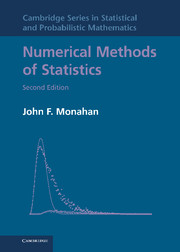Book contents
- Frontmatter
- Contents
- Preface to the Second Edition
- Preface to the First Edition
- 1 Algorithms and Computers
- 2 Computer Arithmetic
- 3 Matrices and Linear Equations
- 4 More Methods for Solving Linear Equations
- 5 Regression Computations
- 6 Eigenproblems
- 7 Functions: Interpolation, Smoothing, and Approximation
- 8 Introduction to Optimization and Nonlinear Equations
- 9 Maximum Likelihood and Nonlinear Regression
- 10 Numerical Integration and Monte Carlo Methods
- 11 Generating Random Variables from Other Distributions
- 12 Statistical Methods for Integration and Monte Carlo
- 13 Markov Chain Monte Carlo Methods
- 14 Sorting and Fast Algorithms
- Author Index
- Subject Index
- References
2 - Computer Arithmetic
Published online by Cambridge University Press: 01 June 2011
- Frontmatter
- Contents
- Preface to the Second Edition
- Preface to the First Edition
- 1 Algorithms and Computers
- 2 Computer Arithmetic
- 3 Matrices and Linear Equations
- 4 More Methods for Solving Linear Equations
- 5 Regression Computations
- 6 Eigenproblems
- 7 Functions: Interpolation, Smoothing, and Approximation
- 8 Introduction to Optimization and Nonlinear Equations
- 9 Maximum Likelihood and Nonlinear Regression
- 10 Numerical Integration and Monte Carlo Methods
- 11 Generating Random Variables from Other Distributions
- 12 Statistical Methods for Integration and Monte Carlo
- 13 Markov Chain Monte Carlo Methods
- 14 Sorting and Fast Algorithms
- Author Index
- Subject Index
- References
Summary
Introduction
Most of the time, we wish to be blissfully ignorant of the inner workings of any complicated machine. When we drive an automobile, traffic and road conditions demand our concentration, and we would prefer that our attention wander to a favorite song on the radio than to the oil pressure gauge. Only when trouble arises need we concern ourselves with the internal combustion engine, air pressure in the tires, the lever arms in the steering system, or a lug wrench. With as complicated a machine as a computer, most of the time we can likewise treat its inner workings as a collection of black boxes. However, researchers regularly operate a computer at its limits in the same way a race-car driver takes an automobile to the limits of its capabilities. In order to drive safely bumper-to-bumper at 200 mph, a race-car driver must understand the operation of every system of the machine. A researcher must understand the inner workings of the arithmetic of the computer; otherwise, Overflow and Underflow become mysterious demons. Knowledge will not only dispel the fears brought on by ignorance, it will also permit the researcher to control his or her computational destiny and not fall victim to “roundoff error” any more than to “racing luck.”
The first three sections of this chapter present a brief overview of the mechanics of computer arithmetic. Although necessary for ground-level knowledge, they should be skimmed at first reading because the interesting details of the problems can easily sidetrack the reader.
- Type
- Chapter
- Information
- Numerical Methods of Statistics , pp. 13 - 39Publisher: Cambridge University PressPrint publication year: 2011



